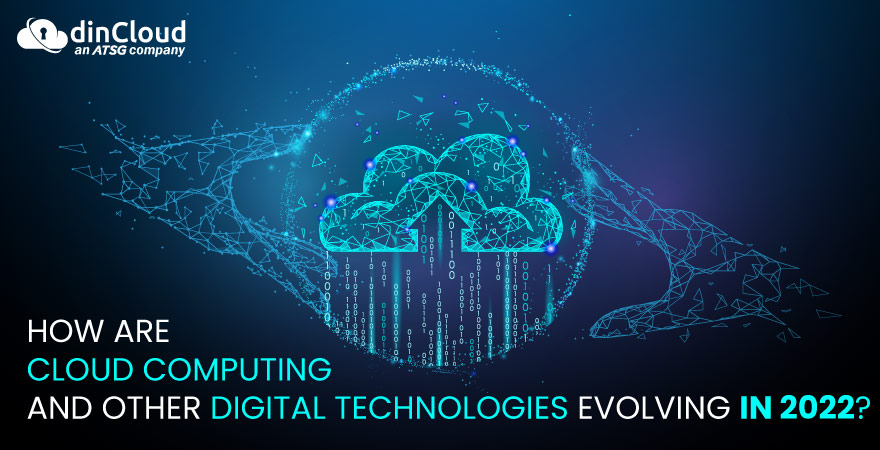When we set foot in the year 2022, we already knew that this would be a very “happening” year for digital technologies. Cloud Computing, and similar digital technologies have remained at the forefront of the pandemic and post pandemic era.
Right now, we find ourselves in a time of consolidation and optimization of the digital technologies that are driving modern business processes. In this post, we will discuss the evolution of some major digital technologies like Cloud Computing, and more.

Why Cloud Computing?
Even before the pandemic, Cloud Computing was proving itself as a strong value proposition for enterprises of all sizes, serving a wide range of industries. However, the Covid-19 pandemic acted as a major catalyst for the growth of Cloud Computing.
The sheer level of flexibility, scalability, efficiency and security that was being offered by leading Cloud Service Providers (CSP) like dinCloud was too good for businesses to pass. Remote and Hybrid work needs further elevated the stature of the public cloud.
The Cloud Evolves from Private to Hybrid Multi Cloud
At the very heart of Cloud Computing infrastructures lies virtualization. In fact, virtualization is truly the heart and soul of modern day cloud infrastructures. However, it all started from within an enterprise, as Private Cloud was the name of the game in the initial days.
However, enterprises soon realized that they were not deriving true value from Private Clouds, mainly due to the associated overheads. In the case of the Public Cloud, all this changes, as storage, compute and processing is consumed by enterprises “as a Service”.
Therefore, we saw a massive increase in the demand for Hybrid Cloud infrastructures. In the hybrid cloud, an enterprise retained the critical data and processes on-premise, while other countless workloads found their way to the public cloud.
The Hybrid Multi Cloud, or the Multi Cloud, has taken the flexibility and functionality of the Public Cloud to a whole new level. In the case of a multi cloud, an enterprise leverages the infrastructure and resources of more than one public cloud provider.
Related: Bridge Your Work from Home (WFH) and BYOD Challenges with DaaS
By doing so, enterprises that deploy the Multi Cloud are able to enjoy the “best of all worlds”. As soon as a deploying enterprise gets past the complexities of a multi cloud deployment, the benefits are every bit worth the time and efforts.
Industry Clouds – The Next Big Move
As multi clouds take hold across the length and breadth of leading industries, the next big move or evolution within Cloud Computing will be Industry Clouds. It would be more appropriate to name them as industry specific clouds.
The data governance, cyber security, regulatory compliance and latency needs of every industry or process are different. Hence, the “one size fits all” is not the most viable approach now, especially when it comes to Cloud Computing solutions and services.
So, we will see a rapid increase in the adoption of industry clouds, which will be formed with the collaboration between Cloud Service Providers (CSP), and enterprise solutions providers. Industry clouds will streamline efficiency, compliance and security a lot.
Related: Leveraging Cloud Computing to Reduce Food Wastage
Edge Computing for Time Sensitive Workloads
Most people initially thought that Edge Computing is the “new kid on the block”, which will eventually end up replacing Cloud Computing. The reality, however, is altogether different. Instead of replacing Cloud Computing, Edge Computing is complementing the former.
Edge Computing deployments bring processing and output in really close proximity to the sources of data. Self driving cars are a classic example of such time sensitive workloads, where even the marginal latency of the Cloud can endanger human life and property.
So far as time sensitive workloads are concerned, Edge Computing will take the lead, while Cloud Computing will still remain equally relevant, in the broader scheme of things. We will see time sensitive workloads increasingly make their way to Edge Infrastructures.
Cloud Gaming to Further Proliferate
When movie and video streaming made its way to the Cloud, very few people had thought that gaming would also end up in the Cloud. Well, here we are, in the era of Cloud Gaming. Leading tech and cloud giants like Amazon, Google and Microsoft are leading the way.
Like other Cloud Computing services, Cloud Gaming is also proving a great value proposition for the millions of gaming lovers across the globe. With cloud gaming, you no longer need to invest in a costly gaming PC, or a proprietary gaming console.
Cloud gaming, like other cloud services, is also following the “as a Service” model. By paying a small subscription fee, cloud gamers now have access to some of the largest collection of high-end games, delivering stellar performance and immersive experiences over the Cloud.
Related: How HCI Solves Numerous Enterprise Pain Points?
Conclusion
Whether its Hybrid Clouds, Multi Clouds, Industry Clouds, Edge Computing or Cloud Gaming, these digital technologies are collectively evolving at a very rapid pace. In this whole process, these technologies are revolutionizing enterprise operations.
Contact dinCloud, an ATSG company, for a wide array of secure, reliable and cost efficient cloud solutions for all your enterprise needs.


